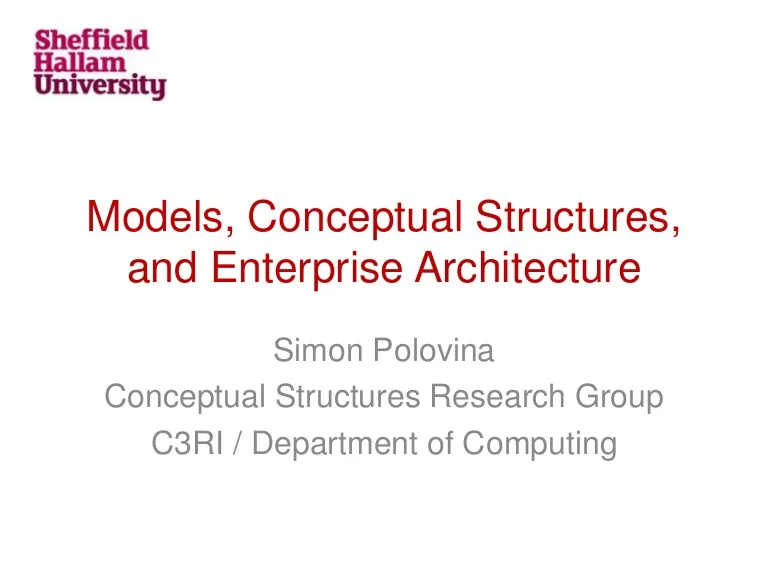Models, conceptual structures, and enterprise architecture
Description
Many disciplines rely on models to represent reality. Models may range from a miniature representation of some physical entity, to a simplified representation of a system or phenomenon so we can understand and test it. Not all models can represent their corresponding real-world entities as easily as a model of a building or a motor car. Models of economic or social systems for instance are representations more of concepts and beliefs than physical forms. An enterprise, such as Sheffield Hallam University, is more than just its buildings, equipment or financial statements. Such visible entities are simply the structures that follow from its strategy, which is just as real. Strategy is moreover the driving entity and the enterprise is ineffective without it. Enterprise Architecture (EA)recognises that enterprises (profit-making or not) are essentially creative human endeavours. They are embodied in conceptual models that sit uneasily ‘on the same page’ with the structural models that depict how enterprises physically organise themselves to achieve those endeavours. These models pull in different directions and the physical entities tend to win out due to their visible presence; history shows the emergence of bureaucratic structures, inter-departmental conflicts, inadequate computer systems and other experiences where strategy is lost and ends up following structure: ‘The tail wagging the dog’. For EA we desire ‘conceptual structures’, which align the expressivity of conceptual models with the simplicity of structural models. In EA frameworks, conceptual structures are presently expressed through ‘metamodels’ that attempt to bring together the conceptual with the structural. The seminar thus explores the adequacy of these metamodels through a simple Financial Trading case study. It is shown that by aligning the conceptual, logical and mathematical levels of the metamodels, constructive relationships can be made between concepts and structures. As such, structures support rather than hinder the human creativity that enables enterprises to better reach their goals.
Transcript
Models, Conceptual Structures,
and Enterprise Architecture
Simon Polovina
Conceptual Structures Research Group
C3RI / Department of Computing
Models of physical entities
Models of systems or phenomena
• Only see through models
• And noting that “All Models are Wrong, But Some are Useful” (Box, 1987)
• Includes models of enterprises, which we can’t touch but are very real
• Understood through “Enterprise Architecture”
Sowa (2002)
Enterprise
• “Space: the final frontier. These are the voyages of the
starship Enterprise. Its five-year mission: to explore strange
new worlds, to seek out new life and new civilizations, to
boldly go where no man has gone before.” (Star Trek, quotes)
• Origin: late Middle English: from Old French, 'something
undertaken', feminine past participle (used as a noun)
of entreprendre, based on Latin prendere, prehendere 'to
take‘ (OED)
• An undertaking, especially one of some scope, complication,
and risk (thefreedictionary.com)
• A business organisation (thefreedictionary.com)
• You and me
Architecture
• The art or practice of designing and constructing
buildings (OED)
• The complex or carefully designed structure of
something (OED)
• The conceptual structure and logical organization of a
computer or computer-based system (OED)
• Winchester Mystery House, Why
• “From a blank piece of paper to the last nail in the wall”
Sowa &
Zachman
(1992)
Enterprise + Architecture
&Today
Ontology
• In Philosophy:
– A theory of being
– “does truth exist?” or “does energy exist?”
• In Computer Science
– Gruber “In the context of knowledge sharing, I use the
term ontology to mean a specification of a
conceptualization. That is, an ontology is a description (like
a formal specification of a program) of the concepts and
relationships that can exist for an agent or a community
of agents. This definition is consistent with the usage of
ontology as set-of-concept-definitions, but more general.
And it is certainly a different sense of the word than its use
in philosophy.” (emphasis added).” (Malik, 2009)
TOGAF (v9.1)
• 1980’s TAFIM (from US DoD)
• 1995 TOGAF v1
• Now v9.1
• Includes the ADM
i.e. the Architecture
Development Method
(as shown)
• And the Content Metamodel
(shown next)
TOGAF’s Content Metamodel
• Meta = ‘about’
• White entities are
“core” and not to be
omitted
• Red/Blue/Green
entities are
“extensions” and can
be omitted
• Entity renaming is
possible
• Modification and
removal of entities is
not recommended
• It’s the base template
for your EA
Domain
Semantics
Rule of 3:
Object Object
relation
An Enterprise (Concepts and Structures)
A (Simplified) SHU EA
SHU's EA, redefined
Architecting a Financial
Trading Enterprise
TRA Inc. buys
and sells
numbers of
shares of
securities and
manages its
clients’ assets.
e.g. ‘Portfolio
Manager’
Creates and
manages
portfolio
Place
(Buy/Sell)
Order
Derive profit
on 'SQQ'
(size,
quantity and
quality) of
transactions.
25% market
share by
2014; Top 3 of
best-of-breed
in Service
polls
Right down to
the Database
server,
Network, …
As a Conceptual Structure
(using Peirce’s cuts)
As a Conceptual Structure
(Logical Level)
Polovina & Andrews (2013)
As a Conceptual Structure
(Mathematical Level)
Polovina & Andrews (2013)
Redefined
(Logical Level)
Polovina & Andrews (2013)
As a Conceptual Structure
(Mathematical Level)
Polovina & Andrews (2013)
Concluding Remarks
• Explored Models
• Enterprise Architecture
• Concepts and Structures
• Examples
– Sheffield Hallam University
– Financial Trading
• Conceptual, Logical & Mathematical
• Questions?
References
See Notes
